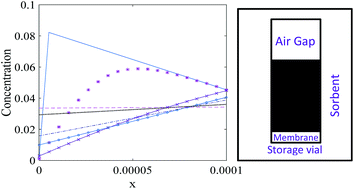New applications of the mathematical model of a permeation passive sampler: prediction of the effective uptake rate and storage stability†
Abstract
As the applications of passive sampling in environmental analysis are increasing, it is crucial to ensure that the methods applied in the measurement of pollutant concentrations provide sufficient accuracy in compliance with existing regulations. Additionally, as with any sampling method in an analytical process, sample integrity is essential for accurate determination of contaminants and their concentrations. In a recent study, a mathematical model was developed to describe the sampling process in permeation passive samplers. The model was able to predict the significance of potential uptake rate changes during sampling. The model also predicted the distribution of the sampled analyte within the different compartments of the sampler. In the present work, the model was extended to include two practical applications. In the first part, a novel method allowing prediction of the effective uptake rate of the sampler is presented. The method accounts for changes in the uptake rate during the exposure time caused by resistance to mass transfer in the sorbent bed, allowing accurate calculation of the time weighted average concentrations. The method was proven to be successful through experimental verification that involved sampling toluene and trichloroethylene using the Waterloo Membrane Sampler (WMS). In the second part, the post-sampling storage period of analytes in the WMS was evaluated. It was found both theoretically and experimentally that analyzing the sorbent only is sufficient to quantify the analytes collected, as the amount retained in the remaining compartments of the sampler (PDMS membrane, air inside the sampler and the storage vial) is negligible after sampling. The amounts of analytes collected by the sorbent were stable over up to three-weeks of storage at room temperature. These findings establish confidence in the use of the WMS for sampling Volatile Organic Compounds (VOCs).



 Please wait while we load your content...
Please wait while we load your content...